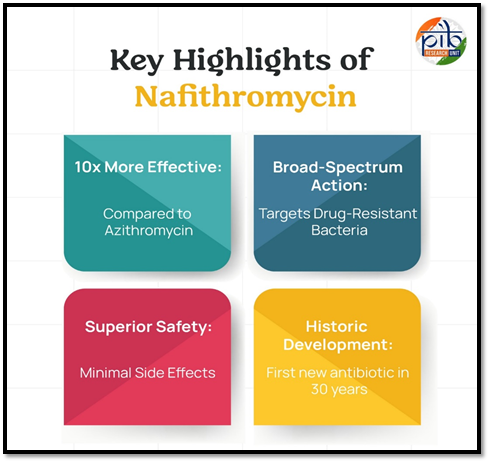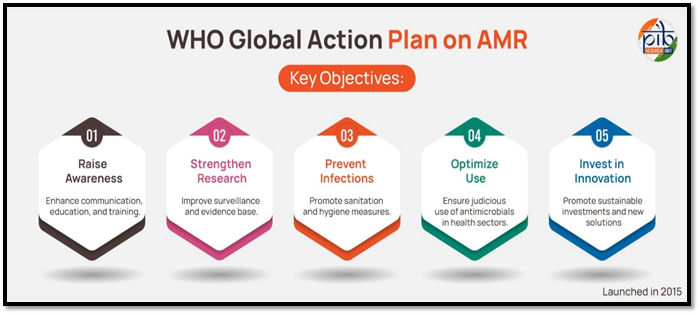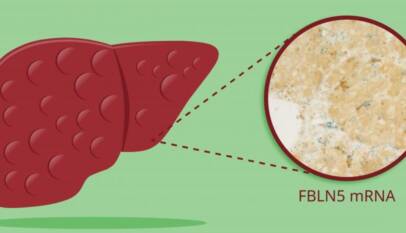Nafithromycin: Country’s First Indigenous Antibiotic
Antimicrobial resistance has long been a growing global concern, with pharmaceutical companies striving to develop new medicines to combat it worldwide. Despite years of challenges and relentless effort, a breakthrough has finally emerged. After three decades of research and hard work, India has led the way with the creation of Nafithromycin, the country’s first indigenous Macrolide antibiotic. This remarkable achievement marks a pivotal moment in the fight against antimicrobial resistance, showcasing India’s growing capabilities in pharmaceutical innovation.
India’s Fight Against Antimicrobial Resistance
Antimicrobial Resistance (AMR) occurs when bacteria, viruses, fungi and parasites no longer respond to antimicrobial medicines. As a result of drug resistance, antibiotics and other antimicrobial medicines become ineffective and infections become difficult or impossible to treat, increasing the risk of disease spread, severe illness, disability and death. While AMR is a natural process driven by genetic changes in pathogens over time, its spread is significantly accelerated by human activities, particularly the overuse and misuse of antimicrobial drugs in humans, animals, and plants. Antimicrobial resistance (AMR) has become a major global health issue, with around 6 lakh lives lost in India each year due to resistant infections. However, India is making significant strides in addressing AMR, particularly through the development of new drugs. Nafithromycin, developed with ₹8 crore in funding under the Biotechnology Industry Research Assistance Council (BIRAC) Biotech Industry Program for Phase 3 clinical trials, is a key milestone in this effort. Since India carries a large share of the global pneumonia burden, introducing Nafithromycin is especially important, as there have been no new antibiotics in recent years. Nafithromycin offers improved patient compliance and is a vital step in combating AMR.
Nafithromycin: Milestone for Public Health
Nafithromycin, was officially launched on November 20, 2024, by Union Minister Dr. Jitendra Singh. Developed by Wockhardt with support from the Biotechnology Industry Research Assistance Council (BIRAC), Nafithromycin, marketed as “Miqnaf,” targets Community-Acquired Bacterial Pneumonia (CABP) caused by drug-resistant bacteria, which disproportionately affects vulnerable populations such as children, the elderly, and those with compromised immune systems.
 This groundbreaking antibiotic is ten times more effective than current treatments like azithromycin and offers a three-day treatment regimen, significantly shortening the recovery time while improving patient outcomes. Nafithromycin is designed to treat both typical and atypical drug-resistant bacteria, making it a crucial tool in addressing the global health crisis of AMR (Anti-microbial Resistance). It boasts superior safety, minimal side effects, and no significant drug interactions.
This groundbreaking antibiotic is ten times more effective than current treatments like azithromycin and offers a three-day treatment regimen, significantly shortening the recovery time while improving patient outcomes. Nafithromycin is designed to treat both typical and atypical drug-resistant bacteria, making it a crucial tool in addressing the global health crisis of AMR (Anti-microbial Resistance). It boasts superior safety, minimal side effects, and no significant drug interactions.
Nafithromycin’s development marks a historic milestone as the first new antibiotic in its class to be introduced globally in over 30 years. The drug, which has undergone extensive clinical trials across the U.S., Europe, and India, has been developed with an investment of ₹500 crores and is now awaiting final approval from the Central Drugs Standard Control Organization (CDSCO).
This innovation exemplifies the power of public-private collaboration and underscores India’s growing capabilities in biotechnology. Nafithromycin’s successful introduction represents a major leap in the fight against AMR, offering hope for treating multi-drug-resistant infections and saving lives worldwide.
Government’s Other Initiatives to Combat AMR
 Other than developing Nafithromycin, the Government of India has taken significant steps to combat Antimicrobial Resistance (AMR) through a series of strategic initiatives aimed at surveillance, awareness, and collaboration. These efforts focus on enhancing AMR containment, improving infection control, and fostering national and international partnerships.
Other than developing Nafithromycin, the Government of India has taken significant steps to combat Antimicrobial Resistance (AMR) through a series of strategic initiatives aimed at surveillance, awareness, and collaboration. These efforts focus on enhancing AMR containment, improving infection control, and fostering national and international partnerships.
- Surveillance and Reporting: National surveillance networks, including laboratories across the country, have been established to generate annual AMR surveillance reports, with data submitted to the Global AMR Surveillance System (GLASS).
- Awareness and Training: Awareness materials on the judicious use of antimicrobials, hand hygiene, and infection prevention have been developed and shared with stakeholders. National Guidelines on infection prevention have been launched, and a “train-the-trainer” program has been conducted across all states and UTs, with ongoing cascading of training at the state level.
- Judicious Use of Antimicrobials: To promote responsible usage, surveillance of antimicrobial use has been initiated at tertiary care hospitals.
- National Action Plan on AMR (NAP-AMR): Launched in 2017, the NAP-AMR aligns with the Global Action Plan on AMR. The plan has been implemented across multiple ministries and was initially set for five years.
- NAP-AMR 2.0 Development: National consultations were held in 2022 across sectors (human health, research, environment, animal husbandry) to develop NAP-AMR 2.0, which includes SWOT analysis and recommendations for AMR research policies.
- Red Line Awareness Campaign: The Ministry of Health and Family Welfare (MoHFW) launched the Red Line campaign to raise awareness about the dangers of using antibiotics without a prescription. The campaign advises the public not to use antibiotics marked with a red vertical line unless prescribed by a doctor.
- ICMR Guidelines: The Indian Council of Medical Research (ICMR) has issued treatment guidelines to regulate the use of antibiotics, especially for common conditions like viral bronchitis and low-grade fever. These guidelines aim to prevent unnecessary antibiotic use.
- Regulation of Antibiotics under Schedule H and H1: Antibiotics are listed under Schedule H and H1 of the Drugs Rules, 1945, ensuring they are only available with a prescription from a registered medical practitioner. Drugs under Schedule H1 are also subject to strict record-keeping, with supply records maintained for three years.
- CDSCO Notification for High-End Antibiotics: The Central Drugs Standard Control Organisation (CDSCO) has included 24 high-end antimicrobials under Schedule H1, mandating strict regulation and oversight to prevent misuse.
Global Cooperation to Fight AMR
- National Centre for Disease Control (NCDC) Collaborations: NCDC collaborates with global organizations and countries to address AMR, focusing on AMR surveillance, capacity building, and specialized lab testing. Notable international collaborations include:
- India-US CDC Partnership: Focused on AMR surveillance, SOP development, and data management using WHONET (World Health Organization (WHO) Network) software, with support for HAI (Healthcare Associated Infection) surveillance through ICMR-AIIMS.
- USAID (United States Agency for International Development) Collaboration: Focused on strengthening AMR containment in six states.
- Indo-Netherlands Collaboration: Pilot project in Andhra Pradesh integrating AMR surveillance with a One Health approach.
- Fleming Fund (UK): Supported training of trainers on infection prevention and control (IPC), strengthening AMR surveillance networks in three states, and conducting surveys on antibiotic use in tertiary hospitals.
- India-Denmark Collaboration: A recent technical collaboration plan to address AMR.
These initiatives aim to address the escalating threat of AMR through collaborative efforts across multiple sectors. Additionally, India’s pharmaceutical industry is vital in bolstering the country’s healthcare infrastructure, providing further support to these AMR containment strategies.
Conclusion
India’s proactive efforts to combat antimicrobial resistance (AMR) through innovative drug development, such as the launch of Nafithromycin, alongside comprehensive national initiatives, underscore the country’s leadership in global healthcare. The commitment to surveillance, awareness, and international collaboration highlights India’s strategic approach to tackling AMR and improving health outcomes. With continued investments in research, capacity building, and partnerships, India is well-positioned to drive meaningful change in the global fight against antimicrobial resistance and contribute to better health worldwide.
Putin Concludes Two-Day State Visit to India, Thanks New Delhi for Warm Welcome
New Delhi, Dec 2025 : Russian President Vladimir Putin on Friday concluded his two-day sta…




















